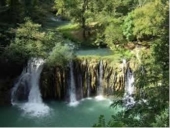
NAME OF THE LOCAL AREA
Park on the river Elsa in the high Elsa valley
COUNTRY
Italy
CITY
Colle di Val d'Elsa
THEMATIC AREA
Math, Chemistry, Biology, Physics
DESCRIPTION OF THE LOCAL AREA
The area is located in Colle di Val d’Elsa. It covers the urban stretch of the river Elsa from “Ponte di Santa Giulia”, south of Colle to “Ponte di Spugna”, in the north east outskirts of the town. It can be reached through a walking route called “SentierElsa” which starts from the two bridges. It includes several cascades, one of which is 15 metres high and over 10 metres deep, and an area called Le Caldane: a warm water spring that was extensively used in ancient Etruscan and Roman times
The Park was established as a protected natural Site of Community Importance by the Municipality of Colle Di Val d’Elsa and the Region of Tuscany with a deliberation of the Consiglio Regionale n 256 on 16/07/1997.
The area is rich in flora and fauna: In the river one can see fresh-water mussels, river shrimps and river crabs. Many vertebrates also inhabit the banks of the Elsa, and it is easy to come across some of them along the banks, as well as many kinds of toads, amphibians and fish: chub, gudgeon, barbel, carpa (a fish which can grow up to 30 kg in weight in this area, thanks to the warmth of the water, that makes this area unique).There are several species of birds to be seen in the river valley, drawn by the abundance of nesting-places and food, including a very fine species of heron, the egret, the wild duck, the moor-hen, the wagtail and finally the kingfisher, easily recognized by its bright plumage
In the park there are two places :Steccaia and the Callone Reale, that are two important pieces of hydraulic engineering.
These works are of great importance to the town, inasmuch as they were used ever since medieval times to divert part of the waters of the Elsa. In this way the water could be used as the driving force for water-mills, in the first instance, and subsequently for paper-mills, steel-works, and for various industrial uses.
In particular, "La Steccaia" ("Pilework") serves to hold back and divert some of the waters of the river Elsa, thanks to a system of movable boards which can be placed between blocks of stone so as to form a dam which prevents the water from flowing freely, while the "Callone Reale" is a sluice which regulates the amount of water which enters the artificial canal which flows towards the city and which provides water to a complex system of canals and pools colled “le gore”.
The date when this hydraulic system was built is unclear; some sources date it to the 10th century. However, we know the exact date when it was restored -- 1606, "under the auspices" of Ferdinando I dei Medici, the Grand-Duke of Tuscany, as is recorded on a commemorative plaque placed by the Medici family itself just below the Callone.
